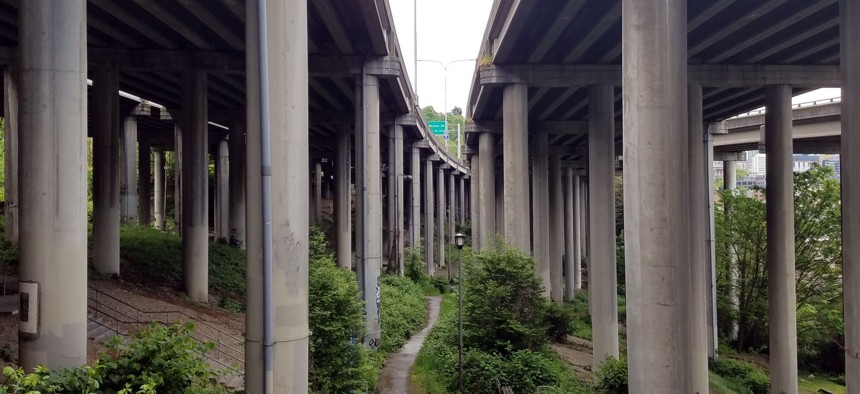This Promising Tech Tool Can Save Lives Before a Major Earthquake Strikes

The I-5 Colonnade park in Seattle. Michael Grass / Route Fifty
As the Trump administration preps to kill ShakeAlert, here's a scenario to demonstrate why funding its continued implementation is critical.
“ The Geography of Disaster Risk and Resiliency in America ” is an ongoing series of Route Fifty dispatches that's part of a larger forthcoming ebook providing snapshots of the very real dangers and disruptions that emergency planners, first responders, public officials and other stakeholders face, plus the strategies and technologies helping our communities be more resilient. | Previously: Alaska
SEATTLE — Imagine it’s a warm, beautiful summer afternoon in the Pacific Northwest. You’re trying to get in some exercise by ascending the numerous stairways and inclines that are part of the I-5 Colonnade, a steep slope under a stretch of elevated freeway that was creatively repurposed as a city park and an urban mountain bike skills course.
It’s not an ordinary freeway overpass. The site, about two miles north of downtown Seattle, is framed by towering slender columns carrying three parallel freeway bridges over the park providing an unlikely scenic view of the Space Needle. Interstate 5’s traffic, although out of sight, murmurs overhead.
All the sudden, warning lights attached to the columns flash and an alert sounds out over a public address system: “Warning: Earthquake detected. Danger. Danger. Strong shaking to arrive in 55 seconds.”
The message repeats itself, as a countdown continues. Additional alerts are relayed to mobile phones across the region warning of impending danger.
A massive magnitude 9.0 earthquake has been detected with an epicenter off the southern Oregon coast along the Cascadia subduction zone, and ShakeAlert, the earthquake early-warning system, has relayed an alert to recipients across the Pacific Northwest faster than the destructive seismic waves can reach places like Portland and Seattle.
“35 seconds,” the warning continues.
There are plenty of places you wouldn’t want to be during the next Cascadia megathrust earthquake in the Pacific Northwest, including, first and foremost, the Oregon and Washington coastlines, which are already bearing the brunt of the most intense shaking and will soon be inundated by destructive tsunami waves.
In Seattle, the I-5 Colonnade isn’t a place you’d want to be either. Bridges up and down the I-5 corridor, the inland backbone of the Pacific Northwest, are just moments away from being put through a major seismic test.
The Washington State Department of Transportation has been steadily replacing and retrofitting freeway bridges along the I-5 corridor since the 6.8 magnitude Nisqually earthquake in 2001 exposed regional infrastructure vulnerabilities. That includes those that were built atop prefabricated hollow columns that can crumble during major quakes. But the list of infrastructure needs in Washington state has been lengthy and the available funding, especially from the federal government, has been less than what’s needed.

Unfortunately, the bridges that comprise the I-5 Colonnade haven’t been retrofitted yet.
“Ten seconds …”
But thanks to an innovative local cross-sector partnership funded by the city and county governments, major tech companies, academic institutions and local philanthropists, ShakeAlert warning systems have been deployed to public spaces, downtown streets and vulnerable locations across the city, including the I-5 Colonnade.
Those who are under I-5’s overpasses have had enough time to get to a safer location away from where the bridge spans could collapse or fracture.
With earthquake early-warning systems, which rolled out nationwide in Japan in 2008 and are also used in Taiwan, Mexico City, Romania and Turkey, seconds count. Lives can be saved.
When connected to physical infrastructure, critical systems, like pipeline valves, can be automatically shut down. Trains can be stopped or slowed to speeds where they won’t derail. Elevators can open on the nearest floor and passengers and escape before the shaking starts. In hospitals, doctors can cease delicate surgical work.
Across Seattle, people who subscribe to ShakeAlert applications via their phones, have been taking shelter under sturdy pieces of furniture or quickly moving away from glass windows, unreinforced brick and masonry building facades and other immediate hazards to ride out what will soon become the largest and most-costly disaster in U.S. history.
“Severe shaking begins in three, two, one.” The shaking starts and it won’t end for another five minutes.
Vulnerable infrastructure across the Pacific Northwest fails, just as been predicted for years. The I-5 Colonnade comes down, too. But other retrofitted bridges ride out the massive quake—or at least don’t collapse.
While the wide adoption and integration of ShakeAlert applications can’t necessarily prevent quake-related deaths and injuries, for thousands of people in this scenario, including those at the I-5 Colonnade, it’s a tool that gave them the seconds they needed to assess their immediate surroundings, identify potential hazards and find the best and safety option available to ride out the severe shaking.
This scenario, is, of course, just a scenario. There is no earthquake early-warning system deployed at the I-5 Colonnade.
The threat the Pacific Northwest faces from a future Cascadia megathrust earthquake is a very real threat, but the use of ShakeAlert technology in the United States is still maturing and not widely available.
A ShakeAlert prototype system that’s been under development on the West Coast—built through partnership with the U.S. Geological Survey, major universities and private partners, including the George and Betty Moore Foundation and Amazon Catalyst—is now being beta tested more widely in California, Oregon and Washington state.
In Bothell, Washington, near Seattle, RH2 Engineering is testing ShakeAlert to secure municipal water and sewer systems. In Oregon, the Eugene Water & Electricity Board is using ShakeAlert to lower water levels in a canal above a residential neighborhood and stop turbines at a hydroelectric plant for large quakes.
“We are thrilled to take the first steps in integrating earthquake early warning into life in the Pacific Northwest,” John Vidale, professor of Earth and space sciences and director of the Pacific Northwest Seismic Network at the University of Washington, said in an announcement in April. “Our teamwork has made it possible to reach this milestone so quickly.”
In California, ShakeAlert is now connected to the control operations of the Bay Area Rapid Transit and Los Angeles Metro rail systems, so trains can be stopped or slowed to reduce the risk of a derailment during severe shaking.
As the Los Angeles Times reported in early June , ShakeAlert warning systems are now being tested by Santa Monica College, where alerts are being tied into office phone systems; fire stations, where garage doors can be automatically opened; and in a Marina Del Ray condominium building where they’re relayed through a public address system linked to smoke alarms.
A Santa Monica-based company, Early Warning Labs , is testing applications to connect building systems to the ShakeAlert warnings. Google, Intel, Microsoft, Bank of America, hospital systems, city and county governments, first responder agencies, and energy and water utilities are among the beta testers to receive alerts.
Unfortunately, as the system is being built out, additional federal funding for ShakeAlert’s continued development is now in question. The Trump administration’s proposed budget cuts for the Department of Interior, which has jurisdiction over the USGS, includes axing funds needed for additional implementation of the earthquake early-warning system.
With no additional federal funding for researchers at CalTech, the University of California at Berkeley, the University of Oregon and the University of Washington, the project will likely be hobbled, just as it’s on the cusp of being made more widely available to create smart systems and applications that can help make infrastructure and quake-vulnerable communities more resilient.
With earthquake risk, it’s always a race until the next major event happens. Unfortunately, seismologists can’t predict when that will be exactly.
The most valuable technological tool to build more quake-resilient communities in the Pacific Northwest, California and other vulnerable areas is a widely deployed early-warning system. Now with federal funding in doubt, it’s also race against time for ShakeAlert’s survival. Time’s a tickin.
Michael Grass is Executive Editor of Government Executive’s Route Fifty and is based in Seattle.
NEXT STORY: Justice Department Joins Accessible Housing Suit Against Los Angeles






